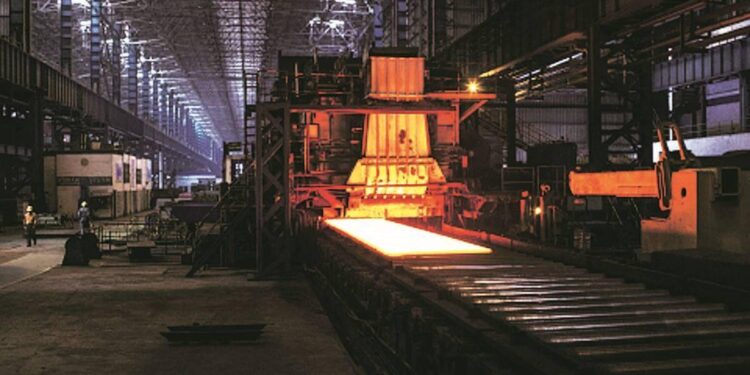 Application of such technologies will enable production of grain oriented electrical steel, non-oriented electrical steel sheet, automotive grade continuous annealed products (AGCAP) and head hardened rails. (Representational image)
Application of such technologies will enable production of grain oriented electrical steel, non-oriented electrical steel sheet, automotive grade continuous annealed products (AGCAP) and head hardened rails. (Representational image)By Kunal Bose
In response to the emerging demand for high quality products for which there is readiness to pay premium prices, the Indian manufacturing industry perforce has to migrate from using middling to superior grades of materials. There are areas that include very high value added steel products and superior grades of aluminium alloys where in the absence or near absence of local supply, the country continues to remain highly import dependent. In order to break this import reliance and in the newly pronounced spirit of ‘aatmanirbharata,’ New Delhi is pushing the leading producers of steel such as Tata Steel, JSW Steel, JSPL and the majority government owned Steel Authority of India Limited (SAIL) to employ the kind of technologies at facilities to be newly built that will allow them to make steels of import substitution kind.
New age steel technologies, globally the preserve of a few, have either to be indigenously developed at considerable investment in research and development (R&D) and fairly long wait or somehow secured from the ones abroad already owning them. Application of such technologies will enable production of grain oriented electrical steel, non-oriented electrical steel sheet, automotive grade continuous annealed products (AGCAP) and head hardened rails. Thankfully, India is slowly but surely making progress in this direction both by way of securing foreign origin technologies and using results of domestically done research. It is, however, only recently that India has started coming out of the parsimony in R&D allocation both by the government and industry. Currently an estimated 0.7% of gross domestic product (GDP) is spent on research, with the government providing 0.6% and private enterprises 0.1%. Speak to experts, they will tell you allocation for R&D should be at least 3% of GDP for the country aspiring to join the ranks of superpowers.
Steel industry leaders here counted among the world’s most cost efficient producers of liquid iron are fast graduating into making import replacing very high value steels through a hybrid approach: access technologies from foreign partners preferably with investment in equities and also building new products based on in-house research. Take JSW Steel, which is targeting capacity expansion to 36.5 million tonnes (mt) by 2024 from 18 mt now has commissioned a special automotive steel R&D centre for development of next generation advanced high strength auto steel that also restricts auto emissions.
On the commissioning of Tata Steel’s joint venture with Nippon Steel & Sumitomo Metal Corporation (NSSSMC) at Jamshedpur some years ago to make AGCAP using continuous annealing and processing line, managing director and CEO TV Narendran said; “The relationship between the two companies goes back 40 years. A technical relationship to start with has now translated into a company where the best of the two will shine.”
While JSW Steel and Tata Steel are benefiting from technology transfer from their overseas Japanese partners, they on their own research continue to enrich their portfolios of high value products (HVPs), some of which are made for the first time in the country. Like Tata Steel has received mandatory approvals to supply API X70 grade steel used in oil pipeline projects. To it also goes the credit for developing high strength, high ductility rebars for use in seismic zones.
In its 2021-22 second quarter results presentation, JSW Steel has given a list of 25 new steel grades/products approved for use by original equipment manufacturers (OEMs). Its introduction of high strength structural steel – galvalume GL – for application in solar panel structure stands as a major breakthrough.
Tata Steel, which is targeting capacity build up of 35 mt to 40 mt by 2030 nurses the ambition to be counted among the five global leaders in steel technology. To make this happen, the company will have to considerably step up its investment in research. That Tata Steel is already doing a decent job in this area will, however, be confirmed by its development of 79 new products in 2020-21 when also it secured 109 patents. Whether it is Tata Steel or JSW Steel, every year they are stepping up sales of VAPs, confirming the progress they are making in technology and brand building. Last year, Tata Steel’s VAPs sales amounted to 7.4 mt when its hot metal production was 13.24 mt.
Steel minister RCP Singh is right that domestic demand for special steels will get a leg up if more and more of these are produced within the country. In order to give a push to building capacity for steels for which import reliance is becoming unacceptably high, New Delhi has introduced the production linked incentive (PLI) scheme creating a buzz in the industry. According to ministry officials, PLI is expected to generate investment of `40,000 crore ($5.37 billion) that will raise special steels capacity to 42 mt by 2026-27 from 18 mt in 2020-21. The application potential of special steels in India will be driven by exponential growth expected in EVs and E battery, green energy, speciality rails, export grade food packaging and e-commerce driven high quality warehouses.
(A former FT correspondent, the author is now India correspondent for Euro Money publication, Metal Market Magazine. Views expressed are personal.)
Get live Stock Prices from BSE, NSE, US Market and latest NAV, portfolio of Mutual Funds, Check out latest IPO News, Best Performing IPOs, calculate your tax by Income Tax Calculator, know market’s Top Gainers, Top Losers & Best Equity Funds. Like us on Facebook and follow us on Twitter.
![]() Financial Express is now on Telegram. Click here to join our channel and stay updated with the latest Biz news and updates.
Financial Express is now on Telegram. Click here to join our channel and stay updated with the latest Biz news and updates.















